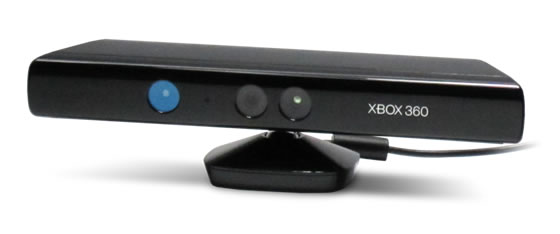The technology giant Microsoft, reported record revenues and earnings per share while disclosing the financial results from its fiscal second quarter.
The company said that its $19.95 billion in revenue and $0.77 per share were driven mainly by the 55 percent growth in the Entertainment & Devices Division. Microsoft credits the Kinect sensor for the upsurge in Xbox 360 console and game sales as well as Xbox Live subscriptions.
Microsoft sold eight million units of its Kinect gaming device, the $150 Xbox accessory that allows for remote-less gameplay. The company estimated that it would sell five million of the devices, but just 60 days after its release, Kinect sales exceeded Microsoft's goal by three million.
 Kinect for Xbox 360, or simply Kinect, is a controller-free gaming and entertainment experience by Microsoft for the Xbox 360 video game platform.
Kinect for Xbox 360, or simply Kinect, is a controller-free gaming and entertainment experience by Microsoft for the Xbox 360 video game platform.
“We are enthusiastic about the consumer response to our holiday line up of products, including the launch of Kinect. The eight million units of Kinect sensors sold in just 60 days far exceeded our expectations,” Peter Klein, the Microsoft chief financial officer said in a statement Thursday. Microsoft's new Xbox Kinect motion-activated video game device, for instance, asks first-time players to strike poses until the unit recognizes them, says David Dennis, Xbox product manager. Thereafter, a player needs only to look directly into the sensor and Kinect will recognize the user and let him or her play. It will also instantly log the user into Xbox Live, Microsoft's online home entertainment subscription service.
According to latest reports it has been declared, that corporate customers bought more Office and server programs and consumers purchased Xbox Kinect motion sensors which led to second-quarter profit exceeding analysts’ estimates as Net income was $6.63 billion, or 77 cents a share, compared with $6.66 billion, or 74 cents, a year earlier, Microsoft revealed in a statement. Sales rose 4.9 percent to $20 billion.Microsoft said the results beat the average projections of 68-cents in profit and $19.1 billion in sales, according to data compiled by Bloomberg.
Companies are installing new Office software and buying more server programs, helping Redmond, Washington-based Microsoft make up for the industry’s lower-than-expected PC sales to consumers. The company also tapped demand for video- game devices, selling 8 million Kinect devices, more than twice its initial forecast.
“They beat on revenue and profit and showed some nice expense control,” said Katherine Egbert, an analyst at Jefferies & Co. in San Francisco. “The business side is good and then Kinect was good.” Second-quarter unearned revenue, a measure of multiyear contracts, was $13.4 billion, missing analysts’ $14.1 billion average estimate, according to data compiled by Bloomberg.
Windows unit sales also fell below estimates as some consumers put off PC purchases and others opted for Apple Inc.’s iPad tablet. The company saw a “small impact” from competition with tablet PCs but it was “not material,” Microsoft Chief Financial Officer Peter Klein said in an interview.
The lower unearned revenue was partially because Microsoft sold more copies of Office to small and medium-sized businesses that bought the software outright rather than through multiyear deals, which fall into the unearned line item, Klein said.
PC shipments in the quarter rose 2.7 percent, below the 5.5 percent projected by researcher IDC in Framingham, Massachusetts, as consumers held off purchases and some opted for Apple Inc.’s iPad tablet computer instead.
Klein expects enterprise PC sales to continue to outpace consumer sales for the rest of Microsoft’s fiscal year. Revenue from contracts that have been signed but not yet billed to the customer rose above $16.5 billion, Klein said. It ended the first quarter above $16 billion.
“Microsoft has been executing extremely well on the business side,” Robert Breza, an analyst at RBC Capital Markets, told Bloomberg Television. “As people start to really focus on Microsoft and what they are doing in cloud computing -- with their Azure platform -- also with their new Office 365 program that sits in the cloud, hopefully that will get the company a little bit more respect.” Breza, based in Minneapolis, rates Microsoft “outperform.”
Operating expenses for the year ending June 30 will be $26.9 billion to $27.3 billion, Microsoft said, reiterating an October forecast. Last quarter, the company was able to hold down expenses, making it the sixth straight quarter in which profit margins expanded, Klein added.
The company doesn’t provide outlooks for sales and profit. Analysts estimate third-quarter earnings of 56 cents a share and sales of $16 billion.
Microsoft also released its overhauled software for mobile phones -- Windows Phone 7 -- during the quarter. The company said yesterday it shipped 2 million licenses to use the software in handsets, a number that analyst Kevin Burden at ABI Research said was disappointing. The company boosted its marketing budget to mount it biggest TV campaign ever for a mobile-phone product.
That was “in line” with what the company was expecting, Klein said.“It’s a good start,” he said. “I recognize that it’s early and we have a lot of work to do and we’re going to continue to focus on that.”
In the Business Division, this makes Office software, sales rise to $6.03 billion, compared with projections of $5.36 billion. Server unit sales gained to $4.39 billion. Analysts predicted $4.2 billion. Xbox unit revenue increased to $3.7 billion, compared with the average $3.74 billion estimate.